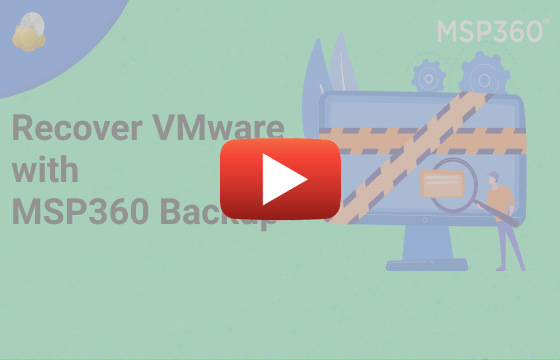MSP360 Products
Restore a VMware Virtual Machine in MSP360 Managed Backup Service
In this video guide, you will learn how to recover your VMware virtual machine which you’ve backed up with the MSP360 Managed Backup Service solution. We’ll overview both the console and the agent.
How to Restore a VMware Virtual Machine in the MSP360 Managed Backup Service Console
Run the MSP360 Managed Backup Service console and, in the RMM tab, click Remote Management. Click the gear icon near a computer with the Virtual Edition of MSP360 Managed Backup Service, then Show Plans.

Click the plus button and choose VMware from the Restore section. This will launch the Restore Wizard.

If you want to recover your machine right now, leave the Run restore once option switched on. Otherwise, click Save restore plan and enter a name.

In the Restore Type section, you determine what version of your machine to restore – the latest one or one at a particular point of time. In the latter case, enter the date and time for recovery.

Connect to the host server with your credentials and administrator privileges.

Specify the storage where your virtual machine is saved. The console will load a list of machines in this storage. Choose the one (or ones) that you want to recover. Turn the Overwrite the existing virtual machine option on if you want to overwrite your VMware, or enter a new name in the Restore As field to create a new machine.

Select a datastore and decide whether or not you want to power the machine off before launching the restore process.

In the Compression and Encryption Options section, enter the password that you used to protect the machine when it was backed up. Skip this step if you didn’t set a password.

If you want to restore your VMware virtual machine regularly, create a schedule for this by clicking the Recurring option and setting up the recovery frequency. Otherwise, click No schedule (run manually) or specify a date to start the plan.

At the end of this section, you can also mark the plan as overdue after a particular period of time from the last success, synchronize the repository before restore, cancel the plan while it’s running if it takes too long, or order the console to run the plan if it was missed. The last three options are not available for a plan that isn’t going to be saved.

Set up notifications.

Click Save. The plan is created and sent to the computer that you specified in the first steps. It will be launched immediately if you’ve chosen the Run restore once option; otherwise, the computer will run it at the time you defined in the Schedule Options.
How to Restore a VMware Virtual Machine in MSP360 Managed Backup Service Agent
When you need to restore your VMware virtual machine, launch the agent and click Restore on the Home panel. This will run the Restore Wizard.

Select the storage where you’ve backed up your VM.

Next, choose whether you want to run a plan right after you finish customizing it, or to save or schedule it for further usage. In the latter case, name your plan.

Select the Restore VMware Virtual Machine option.

Now, decide what version to restore. You can recover the latest one or one that was backed up at a particular point in time, or choose the version manually.

Select the virtual machine that you need to restore.

If you choose to restore the machine or files from it manually, in the Restore Source step, right-click on the backup that you need to restore and select the appropriate option. You will be prompted to enter a password if you’ve set one up.

If you’ve selected Latest version or Point in time, you’ll see another window. Choose the result you need.
- A virtual disk (VMware, Hyper-V, RAW, or VirtualBox).

- A virtual machine in AWS / Microsoft Azure. Just select an appropriate option.
- A fully-fledged VMware virtual machine. Choose Restore to VMware vSphere. This is the most useful option, so we’ll describe this case in detail.
As we’ve chosen a fully fledged machine (VMware vSphere), the server address and credentials are required.

From the drop-down menu, choose the destination datastore. Additionally, define what to do with machines that are powered on; you can switch them off before restoring or recover “as is”. Power them on after the restore if necessary.

If you want, you can overwrite existing machines. If you don’t want to do this, change the name in the Restore as field.
Please note: you can’t restore a machine with the same name without selecting the overwriting option.

If you’ve used encryption, enter your password.

Create a restore schedule, if needed, or run the plan once. You can also choose to synchronize your repository with the storage before restoring, cancel the plan if the restore takes too long, or run the plan immediately after the computer is powered on, if this plan was missed.

Here’s what the schedule interface looks like.

Add a script as a pre- or post-plan action, if needed.

Customize the notification and logging options.

Check the plan summary and, if all is ok, you’re done. If not, return to the appropriate step using Back and make the necessary changes.

With MSP360 Managed Backup Service, you can easily recover VMware virtual machines as virtual disks or working machines, depending on your needs, and, additionally, restore single files from these machines if necessary. If you have any further questions, please contact our pre-sales team.



